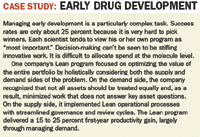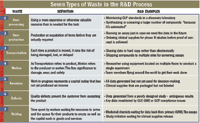Lean Comes to Pharma
Pharmaceutical Executive
The business philosophy and tools that revolutionized Toyota could save the ailing drug industry a lot more than just time and money. But is pharma really capable of getting lean?
These are turbulent times for innovative drugmakers. After years of high margins and deep pockets, the pharmaceutical and biotech industries are now in an era of slower growth and belt-tightening. But drugmakers increasingly recognize that one-time cost cutting isn't enough—their problems run too deep for just a Band-Aid. As senior management searches for new business disciplines that will improve efficiency and productivity, the Toyota Production System and other "Lean" approaches to operational excellence look more and more appealing, with the promise of truly transformative, company-wide change. Just as Toyota revolutionized automaking with its Lean production system, pharma executives are aiming to secure their industry's brave new future by adopting the Lean philosophy and tools.

(NEW VISION TECHNOLOGIES INC / GETTY IMAGES STEPHANIE DALTON COWAN / GETTY IMAGES)
For example, GlaxoSmithKline Bio, applied the concept of "one roof" development from carmaker Renault to its vaccines business by centralizing development in one location. The results were less waste and faster cycle time for decision-making, resulting in the launch of its HPV vaccine, Cervarix, 18 months earlier than the original projection. Other big pharmas are also using Lean to get leaner—though the tendency so far has been toward greater emphasis on manufacturing processes. Last month, the Financial Times reported that AstraZeneca had hired two experts from Jaguar Land Rover to increase efficiency at one of its main factories. Nor are drugmakers the only healthcare industry looking to Lean principles and techniques. According to a September USA Today report, hospital CEOs nationwide are adopting the Toyota Production System concepts and Six Sigma to identify and eliminate waste—initiatives that are likely to expand to meet the cost-cutting requirements of healthcare reform over the next decade.
The drug industry's need to transform its business model, operations, and culture is acute. With challenges on all sides—R&D productivity, rising costs, increasingly complex technologies and product portfolios, competition from generics, and growing regulatory scrutiny—industry market capitalization has declined by two-thirds of a trillion dollars since 2000. Unlike Toyota, which developed its Lean production system over a period of 50 years, pharma doesn't have much time. With an unprecedented number of products going off-patent within the next three years and few blockbusters waiting in the wings, companies are under the gun as never before. If they hope to achieve breakthrough change through the Lean approach, current efforts will have to accelerate and expand.
What Lean Means
When Toyota created its Lean production system in the late 1950s, the Japanese company built a lasting competitive advantage, not just with high-quality, low-cost automobiles but through a fundamentally new approach to business. The foundation was its production system—a total view of how to design, produce, and sell cars that engage the entire company in a shared way of working and a common set of principles. Since then, Lean techniques have moved far beyond the shop floor. And still, the principles of Lean remain the same: an integrated, end-to-end process that combines the concepts of waste elimination, just-in-time inventory and information management, built-in quality, and worker involvement supported by a cultural focus on problem solving and the use of tools such as kaizen (continuous improvement), kanban (ongoing replenishment), and poka-yoke (error-proofing).

Case Study: Early DRUG Development
Could Lean be what the ailing drug industry needs? As pharma executives increasingly recognize the imperative to fundamentally rethink their operations and culture, they look to other industries for new models. Lean has the power to deliver this high degree of transformation. It can streamline core processes, cut cycle times and costs, reduce waste and complexity, and engage the culture in pursuit of continuous improvement, while preserving the innovative spirit that drives the industry.
Yet Lean's basic principles fly in the face of much of pharma's culture. For one thing, pharma has only recently come to appreciate the values of productivity and efficiency. Years of high margins and large budgets engendered a less cost-conscious culture. Another problem is pharma's fiercely independent functions, divisions, and geographic units. The silo mentality remains deeply entrenched at most drug companies. Yet Lean is all about teams, process thinking, and cross-functional collaboration. What's more, Lean's "just in time" principle is at odds with pharma's historical "just in case" culture.
Success requires understanding and managing these challenges. For companies that are up to the task, the potential payoff is sizeable. Well-executed Lean programs in manufacturing can shorten cycle times by 60 to 90 percent, reduce inventory by 40 percent, and cut costs by 10 to 30 percent. New product development, sales force productivity, and marketing effectiveness can also improve.
The New System Blueprint
Before embarking on a Lean program, pharma companies must take to heart a critical lesson from Toyota: Start with a clearly defined business system, including distinct customer segments and their needs, processes for sourcing, developing, producing, marketing, and delivering products, and a well-designed support organization. Designing the blueprint for this system is the responsibility of senior management, not front-line employees. Once this system is in place, Lean programs can optimize it; without it, the full potential of Lean programs will never be realized.
Although the industry has made progress in shaking free from last century's blockbuster business model, most companies are still struggling to define themselves in new, more rational terms. Unlike Toyota, which was operating within a sharply defined framework, the global drug industry is fast-changing and far-flung—and only growing more so with new customer segments, new markets in emerging economies (such as China, India, and Eastern Europe), differing regulatory requirements, customer needs, and market potential. This daunting complexity can lead to Lean programs that are poorly targeted and deliver little strategic impact.

Case Study: Clinical Supplies MANAGEMENT
Before applying Lean techniques, senior management should ask whether a function or activity should exist at all. Does it have value to the customer? Is it on a critical path? Projects that aren't aligned with customer needs or business strategy may eliminate waste or improve cycle times, but the lasting effects will be minimal. For instance, if the goal is to speed up product development, reducing the cycle time of certain toxicology studies won't make much of an impact. Nor will improving operations at a manufacturing plant that's about to lose patent protection on its major products. If capacity utilization is poor, overhead costs are high, cycle times are long, and factor costs are misaligned, the first step should be to analyze whether it would even be possible to match competitors' pricing after patent expiry and a likely loss of volume. And if the answer is no, the right decision might be to make structural changes such as outsourcing or off-shoring production—not launching an intensive Lean effort.
Lean can also transform critical "systems" such as product development. By looking at the end-to-end process and fundamentally rethinking everything from funds allocation to new product introduction, pharma companies can drive major improvements in cost, cycle time, and quality. It took GSK-Bio's one-roof vaccine-development experiment only two or three years to prove its value.
Companywide Application
The relevance of the Lean approach to pharma is at first most evident when applied to manufacturing. In high-value areas where one output becomes an input for the next phase of the process, streamlining, standardization, and cross-functional coordination offer a solution to chronic problems such as long cycle times and excess inventory. By standardizing processes and platforms, Lean efforts can increase the productivity, efficiency, and flexibility of a global supply network. But inventory management poses special challenges. "Too much inventory" is not necessarily a bad thing when the inventory is a lifesaving drug. Moreover, stock-outs in the early, high-margin days of a blockbuster drug must be avoided at all costs. But this is not true of all products. Having large stores of expired products is costly; so is wasting capacity on low-demand, low-margin products. Lean programs aim to optimize global capacity and inventory while ensuring an uninterrupted supply of needed medicine.

Reducing Waste in Clinical Supplies Management
Many of these principles also apply to sales and marketing, where excess inventory and waste takes the form of unused research data, idle sales aids in the car trunks of sales reps, a large number of reviews in the process of developing commercial materials, or downtime of the sales force during visits to physician offices.
Although success of R&D is driven by innovation, other underlying processes are also critical—and lend themselves to Lean optimization. Many activities in drug discovery, development, and life cycle management are repeated, such as protocol review and approval, clinical study data processing, or medical review of sales aids. Lean can standardize and speed up these common processes, and at the same time make it easier for scientists to create customized development pathways for individual compounds.
While waste shows up typically as excess inventory in manufacturing, it can also take the form of masses of unused data in R&D and, later, in sales and marketing. These functions tend to front-load activities in an attempt to compress time lines. In R&D, this includes pre-ordering clinical supplies for future studies, conducting drug-drug or food-drug interaction studies before proof of concept, and commissioning large market research studies many years before filing.
Given the high failure rate of drug development, much of this work and capacity ends up as waste. Lean reduces this waste by focusing attention on experiments and investments that lower the risk of programs, rather than on executing a standardized new product development path with stage-gate checklists and undifferentiated investments. By embracing a "fail fast" approach to drug development and customizing the path to each compound, scientists and managers can become more thoughtful in how they evaluate risks, make decisions, and use resources.

Seven Types of Waste in the R&D Process
Lean's Five Key Steps
Leadership is integral to successful Lean efforts—especially in the pharma industry, where only senior management has an end-to-end view of the whole system and the authority to drive transformation. The most effective approach is a tailored, top-down model followed by broader, bottom-up engagement. Once leadership has communicated its vision for a new business system, employees from throughout the organization should be encouraged to engage, understand, challenge, and come forward with their own ideas for adding customer value, continuous improvement, and greater levels of efficiency and effectiveness.
Other guidelines include:
Start with strategy When beginning a Lean transformation, focus on strategically relevant projects. Many pharmas make the mistake of applying Lean techniques to administrative processes such as regulatory approval—an area that is notoriously slow and bureaucratic. But these redesign efforts tend to be slow. Teams are often large and cumbersome; the effort takes months, and the end result is only a shorter cycle time with fewer sign-offs. Applying the same effort to sales and operations planning, for instance, could make a lasting impact.
Set ambitious goals Lean programs must be far-reaching to be transformative. Don't settle for only incremental or continuous improvements. Aim for high-value, high-impact projects that drive major improvements in performance, as these will help build momentum across the organization. To help prioritize, make sure that every activity either fulfils a customer need or shortens time to market. Don't try to do everything at once, however. Keep scale small at first, then build on the Lean capability and expand the footprint. Broad-scale project proliferation can exhaust an organization before value is realized. Pharma doesn't have time for this.
Focus on the customer Drug companies have a complex mix of customers—patients, physicians, hospitals, payers, and regulators—and the needs of each are increasingly segmented and variable. For instance, many pharma companies are serving developed economies and emerging markets from the same central organizations. Moreover, product portfolios typically are composed of both on- and off-patent drugs, even though the competitive dynamics of branded and generic markets are vastly different. Know who your key customers are, what they need, and, most important, what they'll pay for. Encourage employees to question the status quo in order to find new ways to add customer value.
Look beyond the silo Too often, drug companies limit the impact of their improvement efforts by staying within the boundaries of organizational silos. Greater gains can be made through cross-functional thinking and cross-enterprise efforts. Seek to understand the business system as a whole before optimizing the pieces. This broader perspective will help people see the effect their decisions have on other areas of the organization and overall profitability. Train and motivate people to do what's best for the system, not the silo.
Change mind sets with metrics and incentives Transforming old ways of thinking and behaving is the toughest challenge. To drive sustained change, performance metrics should be tied to the overall goals of the new business system. Develop new incentives and salary structures that promote teamwork and system-wide thinking. This will require looking closely at the mechanisms that reinforce the current silos and counter-productive behavior. Without addressing these fundamental issues, any gains will be short lived. For example, a "fail fast" philosophy in R&D aimed at quickly weeding out products with low potential won't survive if the culture continues to reward progress through stage gates rather than hypothesis-driven decision-making.
Lean can help drug companies do far more with fewer resources. It can also engage and transform the pharma culture in far-reaching ways. These changes won't happen overnight, though—it took Toyota 50 years to refine its Lean production system. Pharma doesn't have that luxury of time, but ambitious, persistent companies with a clearly defined business system can get it right a lot faster than that—and the payoff will be worth the pain.
Adam Farber is a partner and managing director in BCG's Boston office; he can be reached at farber.adam@bcg.com. Ulrik Schulze is a partner and managing director in BCG's Zurich office; he can be reached at schulze.ulrik@bcg.com. Kim Wagner is a senior partner and managing director in BCG's New Jersey office; she can be reached at wagner.kim@bcg.com
The Misinformation Maze: Navigating Public Health in the Digital Age
March 11th 2025Jennifer Butler, chief commercial officer of Pleio, discusses misinformation's threat to public health, where patients are turning for trustworthy health information, the industry's pivot to peer-to-patient strategies to educate patients, and more.
Navigating Distrust: Pharma in the Age of Social Media
February 18th 2025Ian Baer, Founder and CEO of Sooth, discusses how the growing distrust in social media will impact industry marketing strategies and the relationships between pharmaceutical companies and the patients they aim to serve. He also explains dark social, how to combat misinformation, closing the trust gap, and more.
